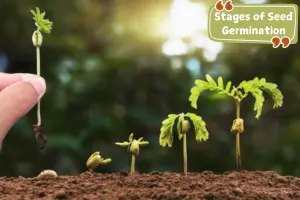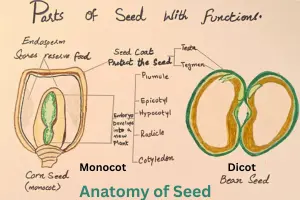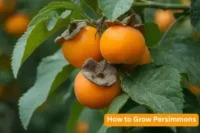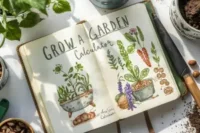How to Store Seeds: Tips for Seed Longevity
Published: 27 Nov 2025
Greetings, Nature Lovers!
How can you store seeds so they last longer and germinate better, like farmers and gardeners who have done it before? Most large-scale farmers and gardeners store seeds for later planting. Preserving seeds extends their lifespan and improves germination.
Sheila, a seasoned botanist with over seven years of experience, brings her expertise to this guide. This article covers everything from choosing the best containers to understanding temperature and moisture control.
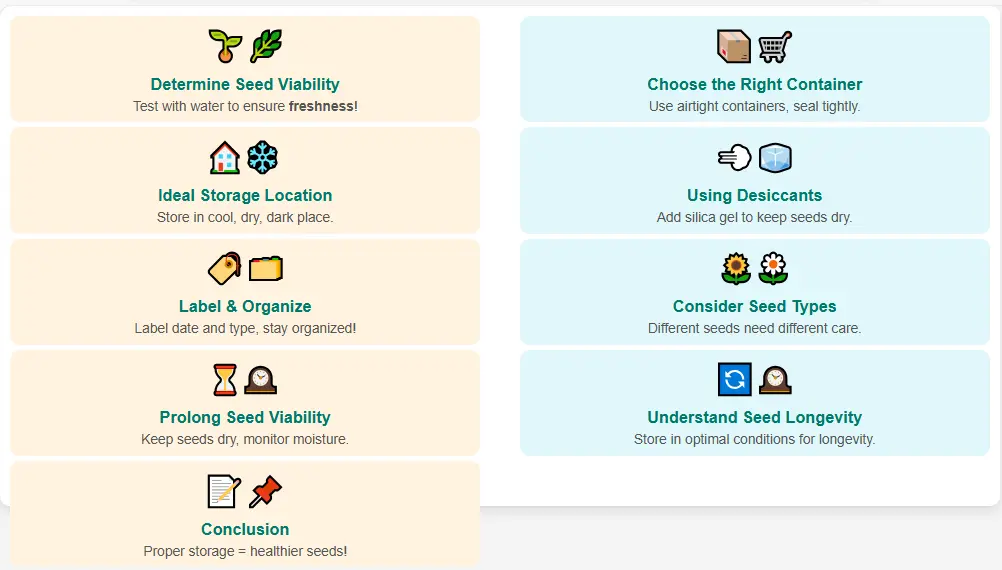
By the end of this article, you’ll have a clear, actionable plan for storing seeds like a pro, setting you up for successful planting seasons ahead. So, let’s travel together to discover how to keep your seeds fresh and ready, like fine wine seeds stored well, which will improve your chances for a flourishing garden.
How to Store Seeds: Best Seed Storing Practices
Seed preservation methods have been created to provide the best environment for seeds. Many farmers and gardeners use different strategies depending on the type of seed. We will take an overall view of all the best techniques.
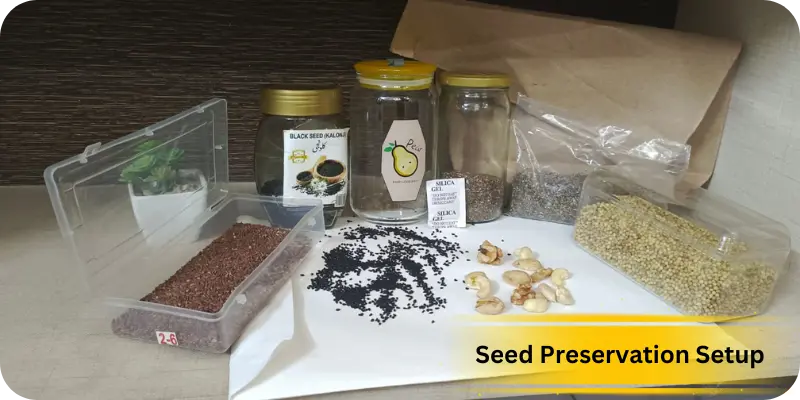
How to Determine Seed Viability Before Storage
Place a few seeds between wet paper towels to check their viability. Store seeds that grow within a week.
Required Tools:
- Glass jars
- Vacuum-sealed bags
- Paper envelopes
- Desiccants (e.g., silica gel)
- Labels and markers
Step 1: Choosing The Right Container
- Glass jars: Glass jars need to keep air and wetness out, but they can let light in.
- Vacuum-Sealed Bags: Vacuum-sealed bags keep air out but can be pricey.
- Paper envelopes: Paper envelopes are cheap but need to keep wetness out. They’re perfect for storing things for a short time.
Step 2: Ideal Storage Location
Keep seeds in a cool, dry, and dark place. Like:
- Refrigerators: As a general rule, refrigerators maintain a cool environment.
- Basements: Basements are usually dark and cool, but you may need to control the temperature.
Step 3: Using Desiccants
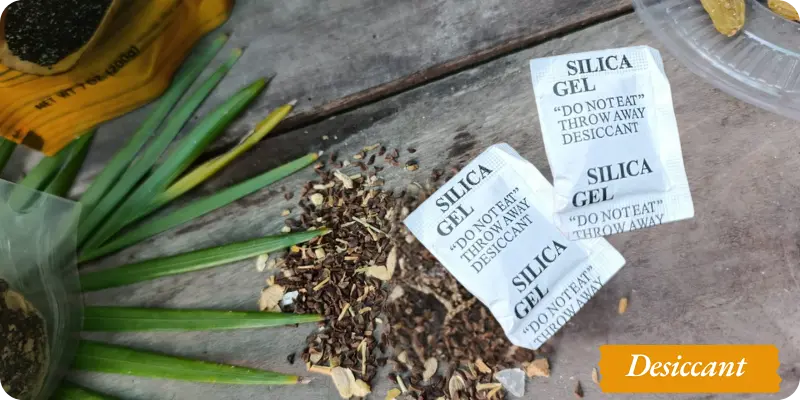
- We may add desiccants in a fluctuating environment. Desiccants, such as silica gel, effectively manage moisture in storage containers, thereby increasing seed longevity by preventing dampness and premature germination.
- Add Desiccants to Containers: Place silica gel packs or dry rice inside the container containing the seeds to absorb any excess moisture.
- Check and Replace Desiccants: Regularly inspect desiccants to ensure their effectiveness and replace them when they become wet.
Step 4: Labelling and Organizing Seeds
Note the type of seed and the storage date on the label of each jar or container. Organize and classify your seeds so they are easily accessible and have an expiry date.
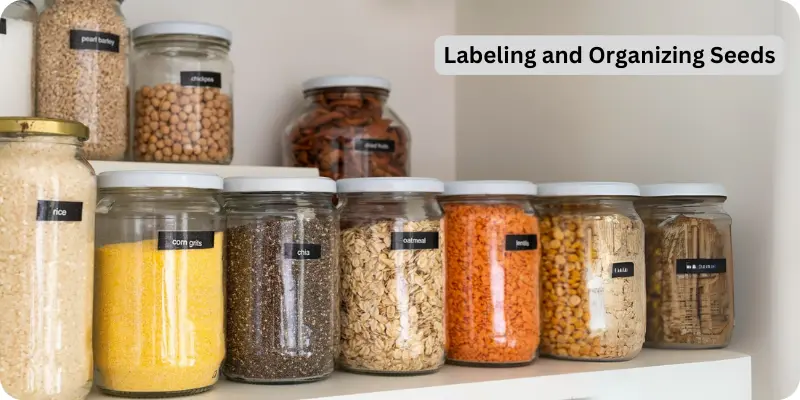
He who plants a tree plants a hope. Lucy
Special Considerations for Different Seed Types
The natural lifespan of different seeds varies with their types.
| Short-Lived Seeds | Long-Lived Seeds |
| Keep them in good condition and use them as soon as possible. | These seeds need careful storage to survive. |
| Examples: Parsley and onion seeds survive 1-2 years. | Examples: Bean and tomato seeds typically last 4-6 years. |
| Heirloom Seeds | Hybrid Seeds |
| Heirloom seeds are open-pollinated and remain genetically stable. | Cross-breeding may produce hybrid seeds with superior features but unstable offspring. |
| Example: The lifespan of tomato seeds can last 4-6 years when stored properly. | Hybrid seeds are more productive but may store poorly. |
| Example: The lifespan of tomato seeds can last 4-6 years when stored properly. | Example: Hybrid corn seeds last 1-2 years when stored properly. |
Tips for Prolonging Seed Viability
Here are some additional tips for seed longevity:
- The germination rate will decrease if seeds are stored for over five years.
- Use a refrigerator or a Ziploc baggie to keep seeds briefly.
- Using a mason jar or a vacuum-sealed container is best if you preserve seeds for an extended period.
- Use silica gel or rice in case of fluctuating environmental conditions.
- If you’re storing seeds for an extended period, mark the container with the date and type of seed.
Common Mistakes to Avoid
Even if you store seeds with care, a few simple mistakes can quietly ruin their future potential. I’ve made some of these myself early on and learned how minor oversights can waste an entire season’s effort.
Think of seeds like tiny bank vaults of life. They need protection and precision.
The most common mistakes while storing seeds are:
1- Storing Seeds in the Kitchen (Too Hot to Handle!)Kitchens may seem convenient, but they’re one of the worst places to store seeds. The temperature changes constantly during cooking, and heat accelerates seed aging, just as fruits ripen faster in warmer conditions. I once kept seed jars above the fridge, and most of them lost viability within months. 2- Keeping Seeds in Paper Bags in Humid AreasHumidity is a quiet killer. Paper absorbs moisture from the air, and soon your seeds can develop mold or sprout prematurely. It’s like leaving your books outside on a damp day; they don’t survive long. Always store seeds in dry, sealed containers, especially during monsoon or rainy seasons. 3- Not Labeling or Dating SeedsIt may feel like you’ll remember, but months later, every seed packet starts to look the same! Without labels or dates, it’s impossible to track the age or type of the seed. I’ve had to toss whole batches just because I wasn’t sure what they were or when I saved them. Label now, save later. 4- Using Leaky or Weak Plastic BagsThin plastic bags can tear, invite moisture, or lose their seal over time. It’s like storing milk in a cracked jug; disaster is inevitable. Use solid, airtight containers or zip locks with proper seals. Bonus tip: Tuck in a silica gel packet to fight hidden moisture. |
Understanding Seed Longevity
Seed longevity is the ability of seeds to remain viable for germination throughout their lifespan. A proper storage system plays a vital role in extending seed longevity. Here are the main factors:
- Temperature
- Light Exposure
- Oxygen and Air
- Moisture Level
1. Temperature: Keep seeds dry and cool to maintain their vitality. Seed storage is optimal at 59°F (15°C) with a relative humidity of 40%–60%. Avoid storing seeds at temperatures over 68°F (20°C) or below 33°F (1°C), as lower temperatures slow seed respiration and energy storage.
2. Light Exposure: Light can accelerate seed degradation. Seeds should be stored in dark environments at all times.
The seeds of today are the flowers of tomorrow. Matshona Dhliwayo
3. Oxygen and Air: Oxygen exposure breaks down seeds over time.
4. Moisture Level: It is vital to maintain humidity at a low level, ideally below 40%. Extreme humidity levels can absorb moisture, which can, in turn, cause early seed germination or deterioration.
| Interesting Facts |
|---|
1: In 1984, seeds were sent to space and successfully grown. 2: Coconut is the largest seed, capable of floating across oceans. |
Conclusion
In conclusion, knowing how to store seeds is crucial for survival and growth. You may increase the lifespan of your seeds by using suitable containers, managing temperature, and adding desiccants when needed.
Remember that different seed kinds require specific care to germinate and thrive. Follow these instructions for effective germination and healthier plants.
Want to improve your gardening skills? Check out my other blog posts for expert opinion!
Frequently Asked Questions
Seed storage often leads to a few common doubts for beginner gardeners. Let’s answer the most popular ones with clear and straightforward guidance to help you confidently store seeds.
Seeds can last from 1 to 6 years, depending on the type and the storage conditions. For instance, tomato and bean seeds may last 4–6 years, while parsley and onion may only last 1–2 years. Always test older seeds before planting.
Glass jars with tight lids or vacuum-fastened bags work best. They keep out air, moisture, and pests while allowing you to organize and label your seeds clearly. Avoid transparent jars if seeds are exposed to light.
Wrap 5–10 seeds in a damp paper towel and place them in a warm area. If most sprout within a week, they’re viable. This quick test saves time and effort during planting season.
Yes, generally, heirloom seeds are open-pollinated and often have better longevity. Hybrid seeds can be productive but don’t always store well and may lose vigor quickly. Store both types properly for best results.
Inspect seeds periodically for moisture, pests, or mold. If necessary, refresh the desiccants and ensure the containers remain sealed. This routine helps maintain seed quality over time.
It is best to store each seed type in separate, labelled packets or jars. Mixing can lead to confusion or even cross-contamination. Label everything clearly with names and dates.
Plastic bags aren’t ideal unless you include a desiccant to control moisture. They can trap humidity and cause seeds to rot. For better results, use paper envelopes or vacuum-sealed bags.
Yes, drying is essential to prevent mold and spoilage. Spread them on paper in a cool, shaded area for at least a week. Store only when they feel scorched and crisp.
Yes, seeds can be stored in the fridge if kept dry in airtight containers. The freezer is also safe, but only if the seeds are dehydrated before freezing. Avoid frequent temperature changes to protect viability.
Bad seeds may appear discolored, moldy, or shriveled. They might have a musty smell or show low germination rates. A quick sprouting test helps confirm if they’re still good.

- Be Respectful
- Stay Relevant
- Stay Positive
- True Feedback
- Encourage Discussion
- Avoid Spamming
- No Fake News
- Don't Copy-Paste
- No Personal Attacks

- Be Respectful
- Stay Relevant
- Stay Positive
- True Feedback
- Encourage Discussion
- Avoid Spamming
- No Fake News
- Don't Copy-Paste
- No Personal Attacks
